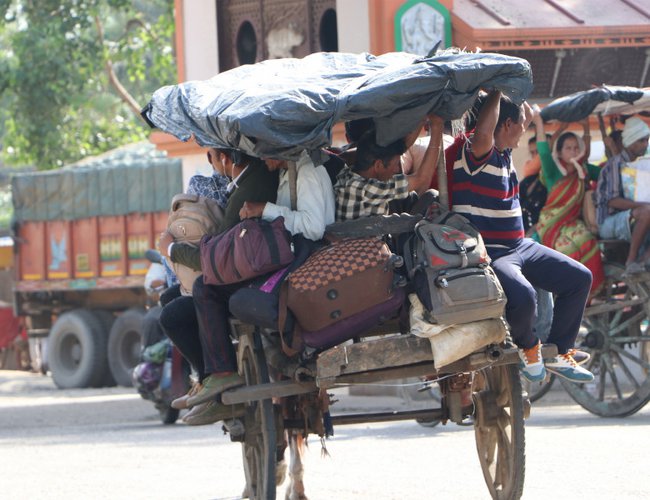
When we recall the first hit of the COVID wave in Nepal, among many other pictures, some of the most heart-breaking pictures were of the migrant workers walking for days without food and water to return home in villages both from major cities in Nepal as well as from India. Some of the most covered stories in media where either the people walking out of Kathmandu to far villages or Nepalese workers in India walking days and night, stranded on the Indian side of the border and jumping off the Mahakali River only to lose life in a hope to reach home. In a few months, we saw a massive return rate of migrant workers to cities and to India proving the prediction of reserve migration that returnees will stay, wrong. How it was a decision made at a junction of two possibilities; staying-and-dying-of-hunger and going- and-dying-of-COVID, is, however, a whole different aspect to be discussed another time.
As COVID is becoming a new reality where we are learning to adjust to life with it, we have time to dig deeper into those media stories and reports. In many of such stories, we see a dark picture of circular labor migration that has undermined workers’ protection, right and stability. With COVID relatively becoming less severe, we shouldn’t forget the uncovered picture of laborers' fragility it showed us. This picture has always been in the frame; was there before the pandemic, and remains in post-pandemic too but only got exacerbated and more visible during this global crisis.
Everyone suffered financially and in many other terms during a lockdown, but the question remains why these wage-based workers suffered the most? It was because they didn’t have enough savings to survive in cities with little or no savings and they didn’t have to enable the environment to raise their collective voices against cut-offs and for financial support from their workplaces- something that happens in a circular economy.
Circular labor migration in Nepal can be most characterized by continuous mobility of workers, a broken chain of sustainable livelihood at home and precarious working condition at destinations. At first glance, we may not observe issues in high labor mobility, but it relates to workers’ stability and protection. Our labor market is designed and operates in a way that short-term employment is promoted. Sometimes employment can be available for a longer term but the arrangement of hiring and job promises are in the shorter term. This means on one hand the workers cannot dream of establishing permanent life there, constantly keeping them in continuous mental stress and worry about what happens tomorrow. On other hand, since they stay in employment for a short period of time, the possibility of collectivizing the voices of workers and negotiating for collective demands is minimal limiting the chances of workers' protection and rights being realized.
Circular labor migration happens from villages to cities and to another part of the border. There was a time when people in Nepal used to grow food for their families in their lands. Now those fertile lands in rural areas remain barren as people have migrated and their families have also shifted to urban areas for services like children’s education and elder’s health. Nepal is also one of the fastest urbanizing nations with productive lands being sold and commercialized with plotting, buildings, and other commercial spaces. This has broken the chain of agriculture-based livelihood which was more self-reliant. Even if workers in circular labor migration now want to return, they cannot because no land and other resources exist anymore, a cycle of generational agricultural and other skill transfer is broken and there is a social stigma of being failed if returned.
Working conditions for circular labor migrants are often precarious because their rights and protection remain unnegotiated and the informal nature of their work allows vulnerabilities. The garments industry in Nepal is full of circular labor migrants and a labor survey report categorizes it as a sector where there is the highest prevalence of sexual violence against workers. There are other industries such as construction and waste collection where not even minimum human safety standards are maintained. The socio-economic discrimination and hierarchies of a person at the source place are reproduced at the destination in circular labor migration. Those at the lowest ladder of society and economy are worst off. For instance, women, adolescent girls, Dalits, people with disability, and illiterate groups face extreme vulnerability.
As the capitalist economy is flourishing, we see the circular nature of labor- work impermanency that compels workers to keep on moving from one place to another in search of work. The dominating actors of the economic sector play a role to make sure migration is circular in nature because keeping it this way gives them the benefit of not having to ensure the protection and rights of workers and makes their wage payment reverse back to them in exchange for services and products.
Circular labor migration is a new reality for Nepal. We cannot reverse circular labor migration overnight as it rapidly growing, and more and more people are being accustomed to it. In this situation, there can be two strategic engagements; i) Working within the system for protecting the rights of workers and ii) Working to change the system itself- systemic transformation into an inclusive and sustainable economy.
(Bindu Sharma is a feminist practitioner active in the field of development cooperation in Nepal.)













